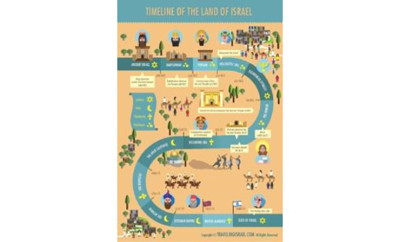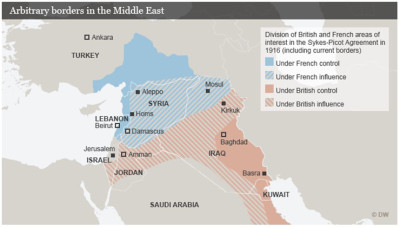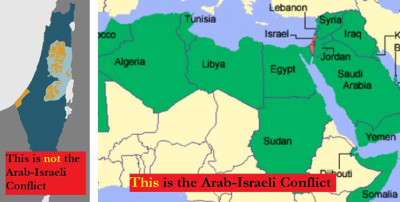




- A Brief History Of The Land
The small sliver of “Holy Land” along the eastern Mediterranean coast was originally inhabited by Canaanites, before they were replaced by the ancient Israelites in the 13th century BCE. Most of the ancient Israelite tribes were eventually destroyed, leaving behind only the Kingdom of Judah, from which the terms “Judaism” and “Jew” (Yehudi) come from. In the 6th century BCE, Judah was also destroyed, by the Babylonians, who exiled most of the Jews back to Babylon. Some seventy years later, Jews returned to rebuild what was now only a province of Judah.
In the 2nd century BCE, the Maccabees were able to establish an independent Jewish kingdom in the Holy Land once more, the Hasmonean Kingdom of Judah. This kingdom fell to the Romans in the following century. The Romans struggled to keep their dominion over the Jews, who revolted three times. The first time resulted in the destruction of the Holy Temple in Jerusalem. The third time, the Bar-Kochva Revolt in the 2nd century CE, resulted in Rome renaming the province of Judea to “Palestine”, after the ancient enemies of the Israelites, the Philistines, who were themselves foreign conquerors of the land hailing from the Aegean across the sea. Muslims Arabs only conquered the area in the 7th century CE, thanks in part to the Jews who lived there:
- Jews Have Had a Continuous Presence in Israel
There have always been large populations of Jews in the Holy Land. In the early 7th century CE, Nehemiah ben Hushiel led a revolt against the Byzantines to re-establish an independent Jewish state in Israel, and nearly succeeded. The revolt was officially put down by 628 CE. Yet, it is this event that actually weakened the Byzantine forces in the area and paved the way for the Muslim Arabs to conquer the territory starting in 634 CE. The Dome of the Rock, opened in 692 CE, was built directly atop the ancient Jewish Holy Temple on the site.
Still, Jews continued to live and prosper in the Holy Land. In the 13th century, the renowned philosopher Nahmanides (Rabbi Moshe ben Nachman, 1194-1270) settled in Jerusalem and rebuilt a Jewish community decimated by the Crusades. In the 16th century, Don Joseph Nasi (1524-1579) got approval from the Ottoman Empire to establish a semi-autonomous Jewish state with a capital in Tiberias. Don Joseph himself was granted the title “Lord of Tiberias”. By that point, Jewish life in Israel was flourishing thanks to a large influx of Jews following the Spanish Expulsion of 1492. The city of Tzfat in particular had a large Jewish presence and was the global centre of Jewish learning at the time, the place where the Shulchan Arukh, the central code of Jewish law to this day, was first published in 1563.
In short, Jews lived and prospered in their Promised Land for centuries, and long before the modern Zionist movement. Jews are the indigenous people of the land. Regardless of that fact, the Arab-Israel Conflict actually has nothing to do with land at all!
- The Arab-Israeli Conflict is Not About Land
Jerusalem is mentioned countless times in Jewish holy books (nearly 700 times in the Tanakh alone). It is the direction to which Jews have prayed for millennia. Meanwhile, the Koran does not mention Jerusalem even once, and Muslims pray facing Mecca. Some Muslims claim that Jerusalem is the so-called “Al-Aqsa” where Muhammad visited. However, serious Muslim scholars admit that “Al-Aqsa” is not in Jerusalem and cannot be Jerusalem. Al-Aqsa is in Saudi Arabia, as is the original Al-Aqsa Mosque. See, for instance, the following video where Maggie Khozam interviews a Muslim scholar discussing the true location of Al-Aqsa available in Arabic at www.youtube.com/watch?v=xKOZVhEOTlk .
Besides, the Koran admits that the land of Israel belongs to the people of Israel. For instance, Sheikh Ahmad al-Adwan has pointed out:
Indeed, I recognize their sovereignty over their land. I believe in the Holy Koran, and this fact is stated many times in the book. For instance, “O my people! Enter the holy land which Allah hath assigned unto you.” [Koran 5:21] “We made the Children of Israel inheritors of such things.” [Koran 26:59] And additional verses in the Holy Book.
Meanwhile, Sheikh Dr. Muhammad Al-Husseini has said:
… the traditional commentators from the eighth and ninth century onwards have uniformly interpreted the Koran to say explicitly that Eretz Yisrael has been given by God to the Jewish people as a perpetual covenant. There is no Islamic counterclaim to the Land anywhere in the traditional corpus of commentary.
Truly, the conflict has nothing to do with the land, as Dr. Tawfik Hamid explains:
Hamid rightfully notes that giving away more land to the Arabs will only further embolden the jihadists.
- There Already Exists a “Palestinian” State
Most of the world’s Arab states were formed following the collapse of the Ottoman Empire at the end of World War I. The victorious British and French divided up the Middle East into various “mandates”, which were eventually carved up into new Arab states and given independence. This is how countries like Iraq (granted independence in 1932) and Syria (independent from 1946) came into existence. Similarly, the British created the Mandate for Palestine to serve as a future homeland for the Jewish people. (For a deeper, eye-opening analysis of this, see our partner publication at https://jewishlink.news/the-end-of-world-war-i-and-the-beginnings-of-the-jewish-state.)
The British Mandate for Palestine included the entire area of what is now Israel and Jordan. The Balfour Declaration of 1917 intended to set up a Jewish state here. Three years later, however, the British changed their mind, setting up yet another Arab state, within Mandatory Palestine, on the east side of the Jordan River. In 1921, the Emirate of Transjordan was born. This was, quite literally, a Palestinian state. The understanding was that the rest of the land of Mandatory Palestine—west of the Jordan River—was to be for the Jews. But even this the Arabs would not accept.
Today, the majority of Jordan’s 10 million people are actually Palestinian, including over 2 million still designated as Palestinian “refugees”. People don’t like hearing it said, but the truth is that Jordan is Palestine. It is the original Palestinian Arab state, carved out of Mandatory Palestine! And that’s why no one made a fuss when Jordan occupied the West Bank until 1967. Why didn’t Jordan create an independent Palestine state back then? It felt no need to do so, because Jordan is the independent Palestinian state, and considered the West Bank to be part of its own territory. In fact, it formally annexed the West Bank in 1950. At one point, Yasser Arafat’s PLO sought to take over Jordan entirely (remember Black September?), a conflict known as the Jordanian Civil War. There is no distinction between “Jordanians” and “Palestinians”. They are one and the same. Heck, even their flags are the same:
Today’s “Palestine” is nothing but a launching pad to attack the State of Israel and banish the Jewish people from their ancestral homeland. This was admitted by countless “Palestinian” leaders and activists, including Awni Abd al-Hadi, who said to the Peel Commission in 1937:
There is no such country as Palestine. ‘Palestine’ is a term the Zionists invented. There is no Palestine in the Bible. Our country was for centuries part of Syria. ‘Palestine’ is alien to us. It is the Zionists who introduced it.
More recently, Hamas minister Fathi Hammad gave televised remarks available at https://www.memri.org/tv/hamas-minister-interior-and-national-security-fathi-hammad-slams-egypt-over-fuel-shortage-gaza.
Brothers, half of the Palestinians are Egyptians, and the other half are Saudis. Who are the Palestinians? Egyptian! They may be from Alexandria, from Cairo, from Dumietta, from the North, from Aswan, from Upper Egypt. We are Egyptians. We are Arabs.
Hammad admitted that the “Palestinians” are simply a front for fighting Jews, on behalf of all Arabs. This was more clearly stated by Zuheir Muhsin, a PLO Executive Council member, in a 1977 interview with the Dutch newspaper Trouw:
The creation of a Palestinian state is only a means for continuing our struggle against the state of Israel for our Arab unity. In reality, today, there is no difference between Jordanians, Palestinians, Syrians and Lebanese. Only for political and tactical reasons do we speak today about the existence of a Palestinian people, since Arab national interests demand that we posit the existence of a distinct Palestinian people to oppose Zionism…
- Reframing the Conflict
With this in mind, we can properly frame the Arab-Israel Conflict. It is not the large and powerful Israel against the small and weak Palestinians. The conflict is a small Israel surrounded by hostile enemy states seeking its destruction. The Palestinians are only the front lines for a much larger regional conflict involving countries like Lebanon, Syria, Jordan, Iraq, and Iran. Israel is the one that is outnumbered and on the defensive. It is surrounded by 22 Arab countries, and about 50 Muslim countries altogether. Israel, the only free democracy in the Middle East, is the one single state of the Jewish people, a tiny sliver of land—yet even this little bit, it seems, is too much for the world to accept.
Understanding the Arab-Israeli Conflict in 5 Easy Points
Typography
- Smaller Small Medium Big Bigger
- Default Helvetica Segoe Georgia Times
- Reading Mode




